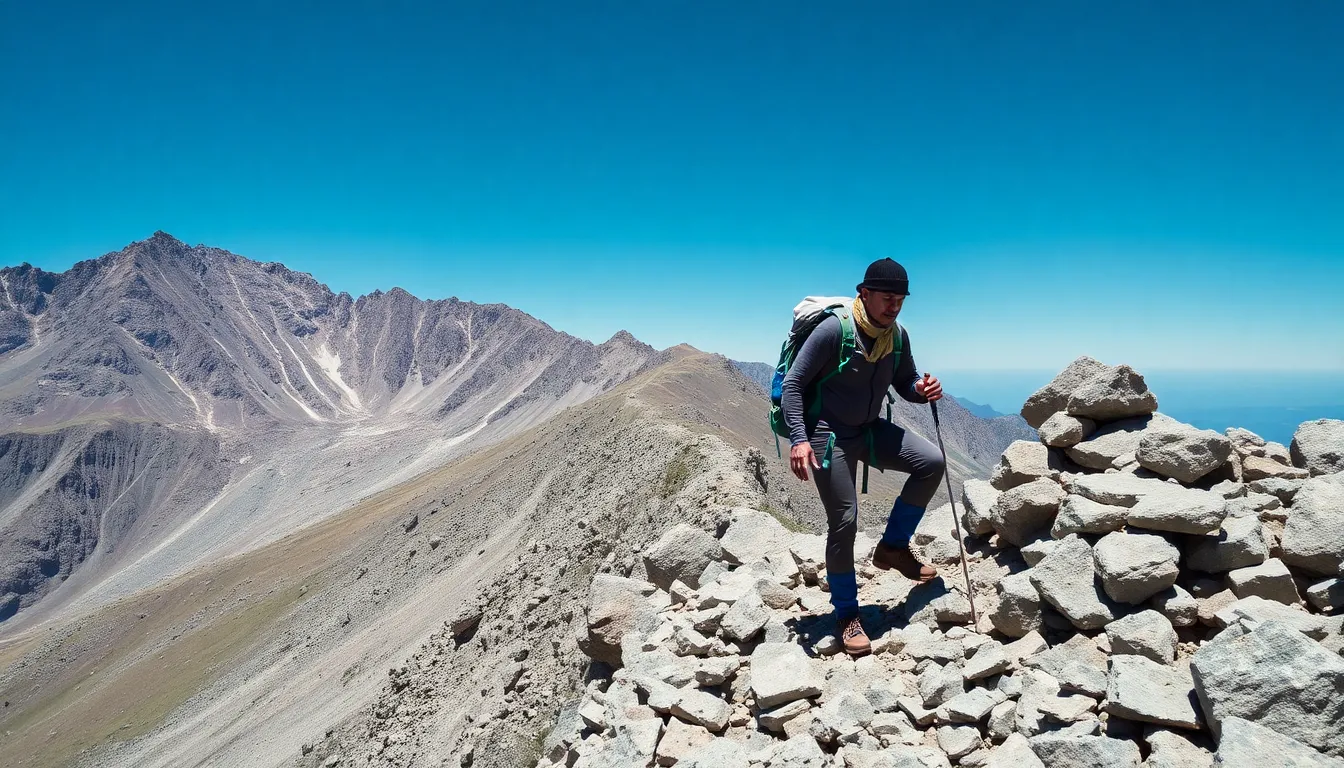Climbing Timgoraho Mountain isn’t just a hike; it’s an adventure that’ll test your mettle and your sense of humor. Picture this: you’re scaling steep paths, dodging the occasional goat that seems to have mastered the art of mountain climbing better than most humans. As the altitude increases, so does the challenge, but isn’t that what makes life exciting?
Whether you’re a seasoned mountaineer or someone who thinks “exercise” is a four-letter word, Timgoraho promises a workout that’ll leave you questioning your life choices—while also providing breathtaking views that make it all worthwhile. So, how hard is it really? Strap on your boots, grab some snacks, and let’s dive into the ups and downs of this exhilarating climb.
How Hard is It to Climb Timgoraho Mountain
Timgoraho Mountain stands as a notable peak in its region, attracting both novice and seasoned hikers. Known for its picturesque landscapes, it offers breathtaking views that reward climbers upon reaching the summit. Trail routes present various terrains, each with distinctive challenges, including steep inclines and rocky paths. Climbers experience both physical strain and the exhilaration of adventure as they navigate these conditions.
Wildlife, such as agile goats, adds an element of surprise to the journey. Hikers encounter these animals maneuvering along narrow ledges, providing both humor and moments of tension. Proper preparation significantly enhances the climbing experience. Many suggest bringing adequate gear, hydration, and nutrition to tackle the challenges ahead effectively.
The climate can shift rapidly, making it essential for hikers to stay informed about weather conditions. Visibility issues may arise, especially during cloudy days, which could impact navigation. Proper timing also plays a critical role. Early morning climbs often provide cooler temperatures and clearer views, making the ascent more enjoyable.
Local guides frequently recommend specific trails that cater to varying skill levels, ensuring a suitable challenge for everyone. It’s common for beginners to feel intimidated, but the community support along the trails tends to foster confidence. Engaging with fellow hikers can enhance the overall experience, allowing for shared stories and encouragement.
Ultimately, Timgoraho Mountain invites adventurers to confront their limits while enjoying nature’s beauty. The climb serves as both a physical test and a chance to forge unforgettable memories.
Factors Affecting Difficulty

Several factors impact the difficulty of climbing Timgoraho Mountain, highlighting the various challenges adventurers may face.
Altitude and Elevation
Altitude plays a significant role in the climbing experience on Timgoraho Mountain. Starting at lower elevations, climbers ascend to heights exceeding 8,000 feet. With increasing altitude, oxygen levels decrease, leading to potential altitude sickness. Symptoms such as headaches and nausea can occur, especially for individuals unaccustomed to high elevation. Some hikers acclimatize by spending time at intermediate elevations before continuing their ascent. Those aiming for the summit must be aware of these effects, as adequate preparation can mitigate risks associated with altitude.
Weather Conditions
Weather conditions can fluctuate dramatically in the Timgoraho region, impacting climbing difficulty. Climbers experience varying temperatures, possibly ranging from warm daytime heat to frigid nighttime lows. Rain and wind may also pose challenges, especially in exposed areas. The risk of sudden storms increases at higher elevations, creating hazardous situations for unprepared hikers. Checking forecasts prior to the climb helps adventurers plan effectively. Dressing in layers and having waterproof gear can provide both comfort and safety throughout the trek.
Trail Conditions
Trail conditions significantly affect the overall difficulty of the climb. Many trails feature steep inclines, rocky terrain, and sections prone to erosion, which complicate navigation. Some paths are well-maintained, while others may require careful attention to footing. Loose rocks and deep crevices can lead to slips and falls, elevating the risk of injury. Hikers should assess their skills and choose trails appropriate for their experience level. Proper footwear and trekking poles enhance stability on challenging sections, improving overall climbing success.
Skill Level Required
Climbing Timgoraho Mountain presents varying levels of difficulty suited for different skill sets. Consideration of personal experience and fitness level influences the overall climbing experience.
Beginner Climbers
For beginners, Timgoraho Mountain offers a manageable challenge. Specific trails, such as the southern route, provide gentler inclines and clearer paths. Climbers new to hiking can benefit from these less strenuous trails while gradually building stamina. Adequate preparation is crucial, including choosing the right gear and bringing sufficient water and snacks. Local guides often recommend daytime climbs for beginners, ensuring safety and support. Group hikes enhance confidence, encouraging less experienced climbers to engage with the adventure. With proper planning, beginners can enjoy the stunning views without overwhelming physical strain.
Experienced Climbers
Experienced climbers encounter heightened challenges on Timgoraho Mountain. Advanced trails feature steep ascents, rocky paths, and more resilient weather conditions, adding intensity to the climb. Those familiar with altitude adjustments thrive in such environments, as many areas exceed 8,000 feet. Navigating treacherous sections often requires enhanced skills and sturdy footwear. Opportunities for technical climbing and exploration attract experienced adventurers seeking to test their limits. Prior knowledge of local ecosystem dynamics also enriches the climb, making it a rewarding experience. Familiarity with navigating changing weather is essential, enabling climbers to prepare for unexpected conditions.
Preparation Tips
Climbing Timgoraho Mountain requires thoughtful preparation. Proper planning ensures an enjoyable and safe hiking experience.
Physical Conditioning
Conditioning plays a vital role in preparing for the climb. Engaging in regular aerobic activities, such as running or cycling, improves endurance. Incorporating strength training exercises can enhance muscle resilience, which supports climbing steep paths. Flexibility exercises like yoga are beneficial for preventing injuries during the hike. Hiking local trails before the climb allows climbers to adapt to varying elevations and terrains. Gradually increasing the difficulty of training hikes builds confidence and stamina. Hydration and a balanced diet also boost overall fitness.
Essential Gear
Selecting the right gear is crucial for a successful climb. Sturdy hiking boots provide support and traction on rocky surfaces. A comfortable backpack is necessary for carrying essentials like water, snacks, and first aid supplies. Weather-appropriate clothing, including layers, protects against temperature changes. A reliable map or GPS device aids in navigation, especially in areas with limited visibility. Trekking poles offer stability and reduce strain on joints during steep ascents. Don’t forget sunscreen and insect repellent to protect against sunburn and bites. Being properly equipped enhances the overall climbing experience.
Personal Experiences
Climbers often share their unique challenges on Timgoraho Mountain. Some recount steep paths that test their endurance. Others describe moments of laughter when encountering agile goats weaving through the trails. Many hikers comment on the variety of experiences based on their skill levels.
Beginners frequently mention how the southern route provides accessible challenges. As they navigate manageable inclines, they can appreciate the stunning scenery. Those who are more advanced tackle the difficult ascents, where practice and familiarity with altitude provide a significant advantage.
Stories of preparation play a critical role in climbing experiences. Many emphasize bringing sufficient hydration and nutrition due to the mountain’s shifting climate. Local guides frequently advise early morning start times, which helps climbers beat the heat and enjoy clearer visibility.
Adventures often include unexpected moments. Wildlife sightings bring excitement, as hikers share tales of close encounters with native animals. Each journey becomes memorable thanks to shared experiences within the community, fostering camaraderie among climbers.
Navigating Timgoraho Mountain requires careful planning. Many recommend engaging in regular aerobic exercises before the climb. Others find that strength and flexibility training greatly improve their overall performance, making the ascent more enjoyable.
Common gear choices reveal what experienced climbers consider essential. Sturdy boots and weather-appropriate clothing frequently top the lists. Navigating tools, along with a well-thought-out pack, contribute to each climber’s confidence on the journey.
Hikers ultimately leave Timgoraho Mountain with unforgettable experiences. Each individual’s story highlights the adventure, offering insights into the triumphs and challenges faced along the way.
Challenges and Breathtaking Views
Climbing Timgoraho Mountain is a memorable adventure filled with unique challenges and breathtaking views. Whether a novice or an experienced hiker each climber can find a trail that suits their skill level while enjoying the camaraderie of fellow adventurers. The blend of physical exertion and moments of humor makes the journey worthwhile.
With proper preparation and the right gear climbers can tackle the diverse paths with confidence. The mountain not only offers a test of endurance but also a chance to connect with nature and create lasting memories. Each ascent is a personal journey that leaves climbers with stories to share and a sense of accomplishment.



